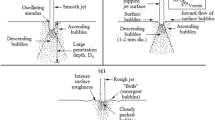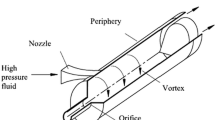Abstract
This study involves an optimization procedure for the factors affecting the performance of the parallel connected vortex tube system using the Taguchi method. The effect of vortex tube inlet pressure, working fluid, nozzle material and nozzle number parameters on vortex tube performance were obtained as a percentage using experimental design and analysis. Experimental studies were carried out at inlet pressures (150, 300 and 450 kPa) with brass and polyamide nozzles having 3, 4 and 5 nozzle numbers using air, oxygen and carbon dioxide as working fluids. These parameters were selected as control parameters and Taguchi L18 orthogonal array was used to design of experiments. According to the optimization study performed with Taguchi method for the ΔT value, which is the performance indicator of the vortex tube, the most important control factor was found to be working pressure (79.50%). The order of importance of other control factors on ΔT was determined as working fluid, number of nozzles and nozzle material, respectively following of inlet pressure. Furthermore, the validity of the optimization was verified with the confirmation experiment.




Similar content being viewed by others
References
Attalla M, Ahmed H, Ahmed MS, El-Wafa AA (2017) Experimental investigation of the effect of nozzle numbers on Ranque–Hilsch vortex tube performance. Exp Heat Transf 30:253–265. https://doi.org/10.1080/08916152.2016.1233150
Kırmacı V, Uluer O (2009) An experimental investigation of the cold mass fraction , nozzle number, and inlet pressure effects on performance of of counter flow vortex tube. J Heat Transf 131:1–6. https://doi.org/10.1115/1.3111259
Kirmaci V, Kaya H (2018) Effects of working fluid, nozzle number, nozzle material and connection type on thermal performance of a Ranque–Hilsch vortex tube: a review. Int J Refrig 91:254–266. https://doi.org/10.1016/j.ijrefrig.2018.05.005
Xue Y, Arjomandi M, Kelso R (2013) The working principle of a vortex tube. Int J Refrig 36:1730–1740. https://doi.org/10.1016/j.ijrefrig.2013.04.016
Aydin O, Baki M (2006) An experimental study on the design parameters of a counterflow vortex tube. Energy 31:2427–2436. https://doi.org/10.1016/j.energy.2005.11.017
Eiamsa-ard S, Wongcharee K, Promvonge P (2010) Experimental investigation on energy separation in a counter-flow Ranque-Hilsch vortex tube: effect of cooling a hot tube. Int Commun Heat Mass Transf 37:156–162. https://doi.org/10.1016/j.icheatmasstransfer.2009.09.013
Markal B, Aydin O, Avci M (2010) An experimental study on the effect of the valve angle of counter-flow Ranque-Hilsch vortex tubes on thermal energy separation. Exp Thermal Fluid Sci 34:966–971. https://doi.org/10.1016/j.expthermflusci.2010.02.013
Simões-Moreira JR (2010) An air-standard cycle and a thermodynamic perspective on operational limits of Ranque-Hilsh or vortex tubes. Int J Refrig 33:765–773. https://doi.org/10.1016/j.ijrefrig.2010.01.005
Avci M (2013) The effects of nozzle aspect ratio and nozzle number on the performance of the Ranque-Hilsch vortex tube. Appl Therm Eng 50:302–308. https://doi.org/10.1016/j.applthermaleng.2012.06.048
Sadi M, Farzaneh-Gord M (2014) Introduction of annular vortex tube and experimental comparison with Ranque-Hilsch vortex tube. Int J Refrig 46:142–151. https://doi.org/10.1016/j.ijrefrig.2014.07.004
Bovand M, Valipour MS, Dincer K, Eiamsa-Ard S (2014) Application of response surface methodology to optimization of a standard Ranque-Hilsch vortex tube refrigerator. Appl Therm Eng 67:545–553. https://doi.org/10.1016/j.applthermaleng.2014.03.039
Agrawal N, Naik SS, Gawale YP (2014) Experimental investigation of vortex tube using natural substances. Int Commun Heat Mass Transf 52:51–55. https://doi.org/10.1016/j.icheatmasstransfer.2014.01.009
Cebeci I, Kirmaci V, Topcuoglu U (2016) The effects of orifice nozzle number and nozzle made of polyamide plastic and aluminum with different inlet pressures on heating and cooling performance of counter flow ranque-hılsch vortex tubes: an experimental investigation. Int J Refrig 72:140–146. https://doi.org/10.1016/j.ijrefrig.2016.07.013
Polat K, Kırmacı V (2011) Determining of gas type in counter flow vortex tube using pairwise fisher score attribute reduction method. Int J Refrig 34:1372–1386. https://doi.org/10.1016/j.ijrefrig.2011.05.010
Polat K, Kirmaci V (2011) Application of the output dependent feature scaling in modeling and prediction of performance of counter flow vortex tube having various nozzles numbers at different inlet pressures of air, oxygen, nitrogen and argon. Int J Refrig 34:1387–1397. https://doi.org/10.1016/j.ijrefrig.2011.03.019
Pourmahmoud N, Rahimi M, Rafiee SE, Hassanzadeh A (2012) A numerical simulation of the effect of inlet gas temperature on the energy separation in a vortex tube. Int J Heat Technol 30:133–140
Seyed ER, Sadeghiazad MM (2014) Three-dimensional and experimental investigation on the effect of cone length of throttle valve on thermal performance of a vortex tube using k-ε turbulence model. Appl Therm Eng 66:65–74. https://doi.org/10.1016/j.applthermaleng.2014.01.073
Thakare HR, Parekh AD (2015) Computational analysis of energy separation in counter-flow vortex tube. Energy 85:62–77. https://doi.org/10.1016/j.energy.2015.03.058
Manimaran R (2016) Computational analysis of energy separation in a counter-flow vortex tube based on inlet shape and aspect ratio. Energy 107:17–28. https://doi.org/10.1016/j.energy.2016.04.005
Rafiee SE, Sadeghiazad MBM (2016) Three-dimensional computational prediction of vortex separation phenomenon inside the Ranque-Hilsch vortex tube. Aviation 20:21–31. https://doi.org/10.3846/16487788.2016.1139814
Thakare HR, Parekh AD (2017) Experimental investigation & CFD analysis of Ranque–Hilsch vortex tube. Energy 133:284–298. https://doi.org/10.1016/j.energy.2017.05.070
Moraveji A, Toghraie D (2017) Computational fluid dynamics simulation of heat transfer and fluid flow characteristics in a vortex tube by considering the various parameters. Int J Heat Mass Transf 113:432–443. https://doi.org/10.1016/j.ijheatmasstransfer.2017.05.095
Bazgir A, Nabhani N, Eiamsa-ard S (2018) Numerical analysis of flow and thermal patterns in a double-pipe Ranque-Hilsch vortex tube: influence of cooling a hot-tube. Appl Therm Eng 144:181–208. https://doi.org/10.1016/j.applthermaleng.2018.08.043
Attalla M, Ahmed H, Ahmed MS, El-Wafa AA (2017) Experimental investigation for thermal performance of series and parallel Ranque-Hilsch vortex tube systems. Appl Therm Eng 123:327–339. https://doi.org/10.1016/j.applthermaleng.2017.05.084
Hong YY, Beltran AA, Paglinawan AC (2018) A robust design of maximum power point tracking using Taguchi method for stand-alone PV system. Appl Energy 211:50–63. https://doi.org/10.1016/j.apenergy.2017.11.041
Haghshenaskashani S, Sajadi B, Cehlin M (2018) Multi-objective optimization of impinging jet ventilation systems: Taguchi-based CFD method. Build Simul 11:1207–1214. https://doi.org/10.1007/s12273-018-0450-z
Dong G, Wijaya G, Tang Y, Zhao YF (2018) Optimizing process parameters of fused deposition modeling by Taguchi method for the fabrication of lattice structures. Addit Manuf 19:62–72. https://doi.org/10.1016/j.addma.2017.11.004
Akyalcin S, Akyalcin L, Bjørgen M (2019) Optimization of desilication parameters of low-silica ZSM-12 by Taguchi method. Microporous Mesoporous Mater 273:256–264. https://doi.org/10.1016/j.micromeso.2018.07.014
Pinar AM, Uluer O, Kirmaci V (2009) Optimization of counter flow Ranque-Hilsch vortex tube performance using Taguchi method. Int J Refrig 32:1487–1494. https://doi.org/10.1016/j.ijrefrig.2009.02.018
Pinar AM, Uluer O, Kırmacı V (2009) Statistical assessment of counter-flow vortex tube performance for different nozzle numbers, cold mass fractions, and inlet pressures via taguchi method. Exp Heat Transf 22:271–282. https://doi.org/10.1080/08916150903099058
Kumar GS, Padmanabhan G, Dattatreya Sarma B (2014) Optimizing the temperature of hot outlet air of vortex tube using Taguchi method. Procedia Eng 97:828–836. https://doi.org/10.1016/j.proeng.2014.12.357
Gökçe H, Çiftçi İ, Demir H (2018) Cutting parameter optimization in shoulder milling of commercially pure molybdenum. J Braz Soc Mech Sci Eng 40. https://doi.org/10.1007/s40430-018-1280-8
Demir H, Korkmaz ME, Çakıroglu R, Gunay M (2019) Optimization of cutting parameters in hard turning of AISI H10A steel under minimum quantity lubrication. Eur J Eng Nat Sci 3:157–164. https://doi.org/10.35940/ijrte.B1008.0782S319
Gokce H (2019) Optimisation of cutting tool and cutting parameters in face milling of custom 450 through the Taguchi method. Adv Mater Sci Eng 2019. https://doi.org/10.1155/2019/5868132
Freddi A, Salmon M (2019) Introduction to the Taguchi method. In: Design principles and methodologies: from conceptualization to first prototyping with examples and case studies. Springer International Publishing, Cham, pp. 159–180
Yadav SKS, Yadava V (2012) Simultaneous optimization of multiple quality characteristics in electrical discharge diamond cut-off grinding (EDDCG). Appl Mech Mater 110–116:250–257. https://doi.org/10.4028/www.scientific.net/AMM.110-116.250
Karatas MA, Gokkaya H, Nalbant M (2019) Optimization of machining parameters for abrasive water jet drilling of carbon fiber-reinforced polymer composite material using Taguchi method. Aircr Eng Aerosp Technol. https://doi.org/10.1108/aeat-11-2018-0282
Moffat RJ (1988) Describing the uncertainties in experimental results. Exp Thermal Fluid Sci 1:3–17. https://doi.org/10.1016/0894-1777(88)90043-X
Günay M, Mehmet Erdi K, Yaşar N (2020) Performance analysis of coated carbide tool in turning of Nimonic 80A superalloy under different cutting environments. J Manuf Process 56:678–687. https://doi.org/10.1016/j.jmapro.2020.05.031
Author information
Authors and Affiliations
Corresponding author
Ethics declarations
Conflict of interest
The author states that there is no conflict of interest.
Additional information
Publisher’s note
Springer Nature remains neutral with regard to jurisdictional claims in published maps and institutional affiliations.
Rights and permissions
About this article
Cite this article
Kaya, H. Evaluation of performance of parallel connected vortex tubes using air, oxygen and carbondioxide with Taguchi method. Heat Mass Transfer 57, 165–174 (2021). https://doi.org/10.1007/s00231-020-02968-w
Received:
Accepted:
Published:
Issue Date:
DOI: https://doi.org/10.1007/s00231-020-02968-w




